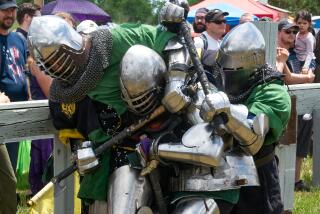Trying to Survive in a Woman’s World : Martial arts: Naginata, an ancient form of individual warfare, is practiced primarily by women. But a Harbor College man is making strides in the sport.
- Share via
Competing in a female-dominated sport can be difficult for a young man, especially when he gets beat repeatedly. Kevin Saxton knows the feeling.
Saxton, a Harbor College sophomore, has practiced martial arts for five years. When he got involved with naginata in 1991, he quickly realized that his ego would have to take a back seat.
“I get my butt kicked all the time,” Saxton said. “My naginata class in Torrance is all women. I felt a little odd at first, but now it doesn’t bother me at all that women beat me. They’re very good.”
Naginata is an ancient martial art practiced primarily by women. It employs the use of a six-foot pole with a one-foot curved blade on one end.
Combatants wear body armor and protective masks. Competition takes place on a 12-meter squared court and each match is three minutes long. Three referees award points and the first contestant to receive two points wins.
“It originated in Japan about 1,000 years ago and became really popular in the 12th and 14th centuries,” said Helen Nakano, who teaches naginata in Torrance and Gardena. “It was handed over to women of the samurai class for self-defense and later became a women’s martial art.”
Saxton initially got involved with naginata to improve his kendo skills. Kendo is a form of Japanese wooden sword fighting that employs four 42-inch bamboo slats held together with leather.
He liked naginata so much he began training seriously--for at least one hour, seven days a week--and in July he was named to the U.S. national team. Saxton made the cut after a four-day tournament in Aurora, Colo.
Saxton, 23, recently represented the U.S. at the International Naginata Federation Goodwill Tournament at Cal State Dominguez Hills. It was the first time the event was staged in the United States. Seven countries participated in the event and the U.S. men placed second to Japan, which has dominated the sport for years.
Saxton finished fourth in the individual competition and earned the fighting spirit award. He went into double overtime against New Zealand’s Alex Bennette in his final match.
“I think I was really outclassed,” said Saxton, who recently earned a first-degree black belt in naginata. “The Japanese team is almost unbeatable. I was also real nervous because it was my first international event.”
Nakano, who has the equivalent of a sixth-degree black belt ranking, believes Saxton’s performance was impressive. Nakano, a resident of Torrance, is the president of the U.S. Naginata Federation and is considered the premier naginata teacher in this country.
“He did extremely well considering it was his first time up against top competitors from different countries,” Nakano said. “And he competed against all males. Mostly he practices against women.”
Saxton says one of the tournament’s highlights was when he practiced sparring with Japan’s female national champion. He believes she’s tougher than a lot of the men he has faced.
“She whipped me so bad it’s not even funny,” Saxton said. “She hit me three times and I don’t even remember seeing it. She’s that good and that graceful.”
Saxton, who is 5-foot-5 and 160 pounds, has trained in Japan with the world’s naginata and kendo elite. He says kendo will always be his first love, although he plans to train hard in naginata in an effort to make the 1995 U.S. team that will compete in the World Championships in Tokyo.
Saxton has won four kendo titles, including events in Gardena, Torrance and Covina. In February he won a national kendo tournament in Canada.
Running about 15 miles a week helps Saxton stay in shape for the martial arts. He used to be a competitive runner, finishing the 1989 L.A. Marathon in 3 hours 19 minutes and the ’89 Long Beach Marathon in 4 1/2 hours.
At Narbonne High, Saxton competed in track and cross-country for two years. He says, however, that cardiovascular conditioning is not always enough when it comes to naginata.
“It’s about 90% mental,” he said. “It’s also more grace and fluidity and women are naturally more graceful than men. The men I compete against are more aggressive and powerful.”
And as Saxton knows well, that’s not always enough to earn a victory in the female-dominated martial art.
More to Read
Go beyond the scoreboard
Get the latest on L.A.'s teams in the daily Sports Report newsletter.
You may occasionally receive promotional content from the Los Angeles Times.










